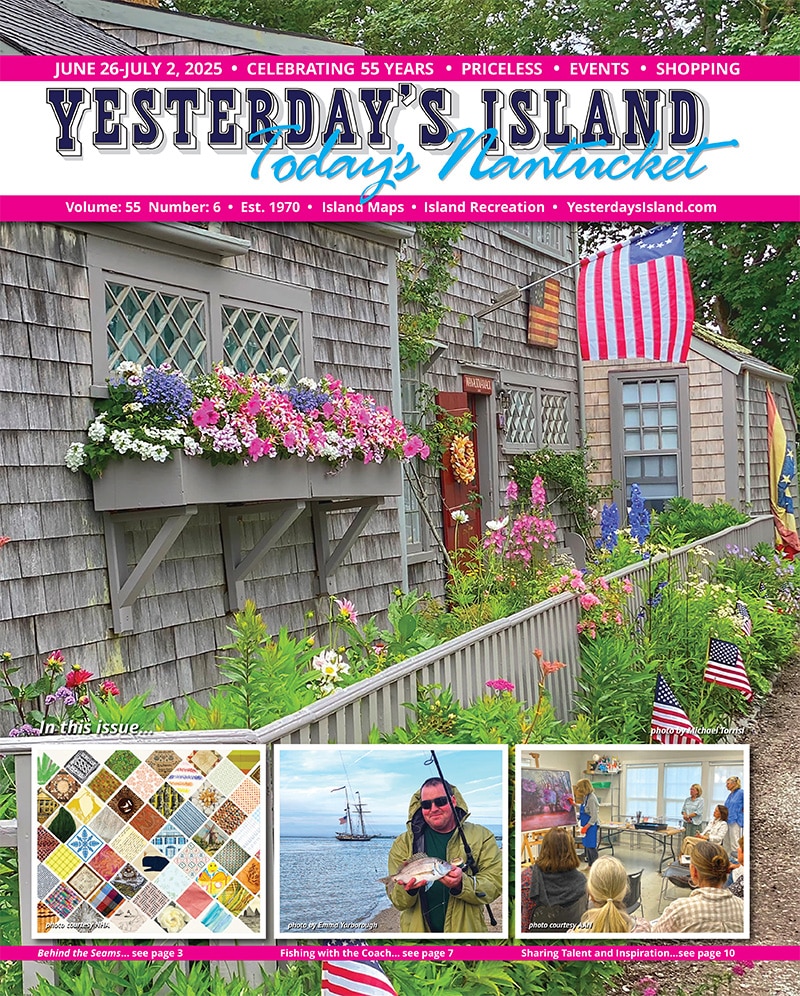by Dr. Sarah Treanor Bois
Director of Research & Education at the Linda Loring Nature Foundation
Did you know that Nantucket has (or had at one point) more than 15 species of wild orchids?
When asked, most people probably think about tropical climates, humid greenhouses, and the fragile house plant. With few exceptions, our native orchids may not be as showy as the tropical orchids of the florist trade. However, like many on Nantucket, they are a much hardier lot.
Our native orchids are remarkable for their diversity and their adaptations. Almost all of our orchids are rare and confined to specialized habitats. For some of our native orchids, these specialized habitats have meant a rarity or potential extirpation from the island. There are some species, however, that are still locally common enough that you may be able to catch a glimpse of one of these special native plants.
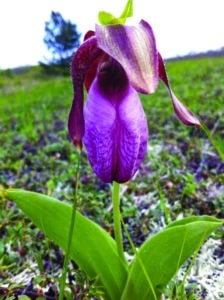
photo by Sarah Bois
People all around the island have been remarking on, photographing, and sharing sightings of native orchids lately. What makes a plant an orchid? Members of the family Orchidaceae are all perennial herbs which feature unusual bilaterally symmetric flowers with three petals and three sepals. Two of the petals are lateral and one forms the lower “lip.” They have masses of pollen known as pollinia, and tiny, dust-like seeds. The unique flower shapes (looking like insects and birds) as well as colors have made them prized in the floral trade throughout the world.
On Nantucket, our most popular (or the one seen the most) is the pink ladyslipper orchid (Cypripedium acaule) which is hard to miss when in bloom as it is on-island right now. As the name suggests, the lower section of the orchid flower, the lip, forms an inflated pouch with a cleft in the center. The pink to white coloring of this pouch causes it to resemble a ballet slipper. This orchid is locally common, with each plant growing a single flower. These individual flowers tend to grow in clusters, so where you see one, you may see several.
Off-island, the pink lady slipper is considered a woodland plant. On Nantucket, it occurs in more diverse habitats – the heathlands of Head of the Plains, or shrublands of the south coast. At the Linda Loring Nature Foundation, a heathland clearing between pine groves has often held dozens of lady slippers. In 2019, after restoration efforts cutting Japanese black pine trees, the cleared area was awash in pink lady slipper plants. Some were only vegetative (not blooming that year), but there were hundreds appearing after the pine clearing.
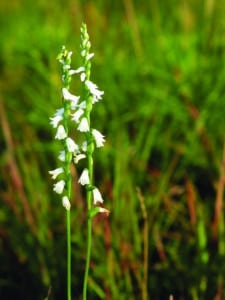
photo by Douglas McGrady
Little ladies’- tresses (Spiranthes tuberosa) is an orchid species at the northern end of its range on the island. More typically found in southern states, where it is relatively common, it is a rarity in New England where it occurs in Connecticut, Rhode Island, and southeastern Massachusetts. Little ladies’-tresses is one of my personal favorites to see, with its spiral of tiny white orchid flowers evoking its own name. It can be found in disturbed fields and meadows. On Nantucket, it is found in our sandplain grasslands. Standing only about six inches or less in height on a slender stem, the tiny spike or white blossoms can be seen during August and September.
The comparable, nodding ladies’ tresses (Spiranthes ceruna) has a thicker stem and grows in open, moist habitats, like wet meadows. The similarly arranged spiral flowers are more creamcolored than Little ladies’-tresses. Nodding ladies’ tresses also has a much broader range overall, extending north into northern Maine blooming late summer into fall.
One of the island’s showiest orchids, Grass pink (Calopogon tuberosus), an orchid found in bogs and wet scrapes (Windswept cranberry bog, for example), has large magenta flowers. It can be found flowering in June into July, so keep an eye out when walking in the bogs or freshwater marshes. Standing at almost a foot tall, each stem bares 2 to 6 flowers. In her 1958 book, A Grain of Mustard Seed, Alice Albertson Shurrocks described Grass Pink (also known as bearded pink) as being delicately scented. She described, “…its petals and sepals point upward in profile like the fingers of a half-opened hand.”
Unlike the lady slippers and grass pink which anyone walking by would notice, Bayard’s adder’s-mouth (Malaxis bayardii) is one of the more demure orchids of Nantucket as well as being a very rare site. Found in dry, sandy fields and heaths it would seem Nantucket is the perfect spot for this orchid. Bayard’s adder’s-mouth is a restricted endemic of northern and central states of the east coast and is only known from a few locations. The small, whitish green flowers could be missed to the untrained eye – this is a very small orchid with tiny, green flowers and a single leaf. Darwin noted in 1877 that the flowers in this genus “though so small and inconspicuous, are highly attractive to insects.” It is pollinated by small flies.
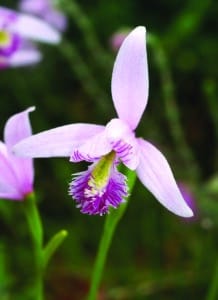
photo by Orchi / CC BY-SA
Another of our pink orchids is the gorgeous rose pogonia (Pogonia ophioglossoides). This plant is often seen in groups in sphagnum bogs, interdune swales, and other wet, acidic sites. Each plant is only a few inches tall with one blossom, but the light rose-colored orchid flowers (about 2 cm in size) help them stick out. The lower lip of the pink flower is protruding, fringed, and bearded in the center with white or yellow hairs making for a striking contrast.
Standing out among the crowd, the white-fringed bog-orchid (Platanthera blephariglottis) is highly specialized to sphagnum bogs and wet scrapes like the old ‘Sconset dump (Nantucket Conservation Foundation). It blooms July-August and the inflorescence may be up to two feet tall! As its name implies, the small white flowers have a fringed lower lip with a distinctive slender spur on the upper part which can as long as an inch. This species produces a dense spike with one stem having 20-40 tiny flowers at the top of the spike. The distinct flower structure of this plant has a gland that secrets nectar which is divided into two parts; each directly beneath a sticky pollen disk. When the pollinator (generally a butterfly) inserts its tongue for nectar, it will touch the pollen disk as well, thus transferring pollen to the next orchid.
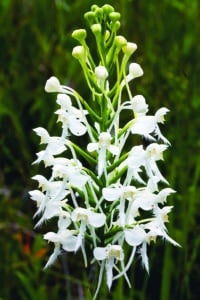
photo by NC Orchid
A large study in Quebec found that the presence and abundance of whitefringed bog orchid was a strong indicator that the sphagnum bog was less influenced by human activity. This species could therefore serve as an indicator of sphagnum bog integrity. Nantucket’s kettle holes ponds and donut bogs of the Middle Moors are good candidates for this species.
This short list of orchids represents those most likely (or not) to be seen. Others that have previously been recorded on Nantucket may have been extirpated (locally extinct) or are simply extremely rare to find. As such, the best way to ensure their continued growth on island is to protect their habitats and the individual plants.
Please do not pick the orchids! Picking may be illegal and will limit the reproductive ability of the plant and can affect the population. They are for the enjoyment of everyone. Orchid flowers are longlasting. Once picked, the plant will likely not flower again until next year, if at all.
Remember to take only pictures and leave only footprints.


